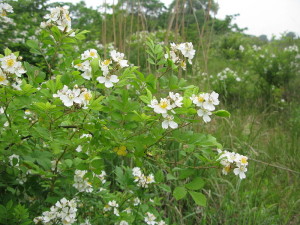
(Photo By: Quert1234 / Wikimedia Commons)
Roses are one of the most popular plants known to mankind. Their history as a cultivated plant goes back at least 5000 years. The Multiflora Rose (Rosa multiflora), also known as Japanese Rose is a native Asian rose that has become invasive in many parts of the United States and Canada. The edibility and medicinal uses of other species of roses is similar and some are even superior to Multiflora Rose, but Multiflora Rose is the most prolific in North America due to its invasive tendencies.
Edibility and Culinary Use
Roses have edible berries called rose hips. Multiflora Rose hips are small but plentiful. I commonly eat them raw but making a hot or cold tea out of rose hips is a popular way to enjoy their unique flavor. To make the tea, mash the rose hips and steep them in hot water.
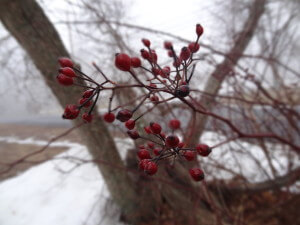
The best time to harvest Rose hips is after the first frost because they become soft and sweet. If they are not soft and sweet at that point it is recommended to keep them on the plant until they are. Depending on the weather, Multifora Rose hips may last until late winter before they begin to get rotten( colder weather seems to preserve them longer). The seeds are edible and perfectly fine to steep in tea, but some people also grind them up and add them to foods for their nutritional content. Rose leaves and flower petals are also edible. They can both be eaten raw, the leaves should be harvested when young, before they develop thorns on the underside. I eat a lot of Multiflora Rose leaves throughout the year, even into winter, I have noticed that I can find young thorn-less leaves all year except for late winter.
Health Benefits
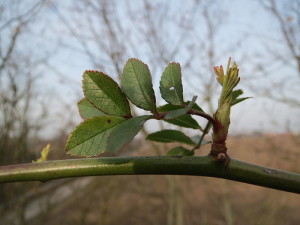
Roses have nutritional benefits that most people are not aware of. Rose hips and leaves are very rich in vitamin C, and the hips are also rich in carotene and a good source of essential fatty acids. The seeds are a good source of vitamin E and are often ground up and added to foods as a nutritional supplement. Roses are being studied as a food that may reduce instances of cancer, and possibly assist in improving cases of cancer.
Key ID Features
Multiflora Rose often grows in a mass of thorny viney stalks. It is commonly seen growing adjacent to other prickery vines and shrubs such as Greenbrier, Raspberry, and Japanese Barberry so knowing that Roses have thorns will not always help you to identify them. On the other hand the shape of the thorns will help you to properly identify Multiflora Rose. The thorns are relatively large and curved, the base of the thorn is a perfect elongated oval. You can break off a thorn and see the perfect oval scar left on the stem. The thorns grow directly on the stems and are located 2″-5″ apart growing on any side of the stem. The easier way to identify Multiflora Rose is by its multitude of small white roses, but they are only present during the summer.
Cautions

THORNS! They are sharp! The other thing to watch out for is that there are stiff irritating hairs inside the fruit protecting the seeds. They are usually not a problem in tea, but if you eat the rose hips raw you might experience some irritation.
Conclusion
If we have to deal with Multiflora Rose as a problematic invasive species, then the least we can do is get something out of it. Like many other invasive species such as Japanese Knotweed and Autumn Olive, this plant also offers us some nutrition and variety to our diets. The vitamin C content alone is enough to persuade us to add Multiflora Rose to our diet. The unique flavor of rose hip tea is a conversation starter and may help more people to learn to appreciate nature and its extreme diversity of wild edibles.
Many of our readers find that subscribing to Eat The Planet is the best way to make sure they don't miss any of our valuable information about wild edibles.
See our privacy policy for more information about ads on this site

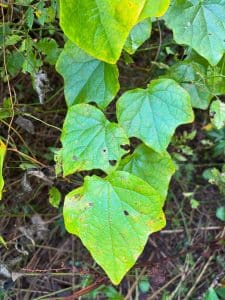
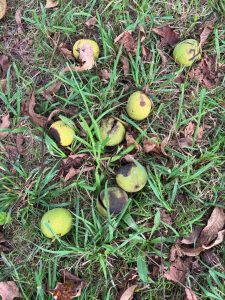
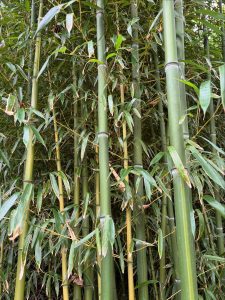
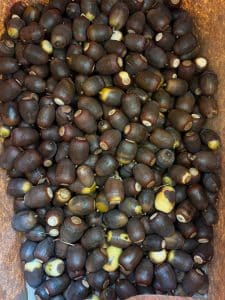
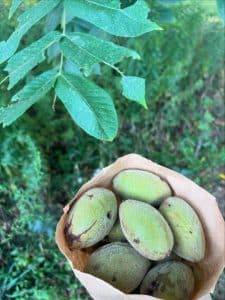
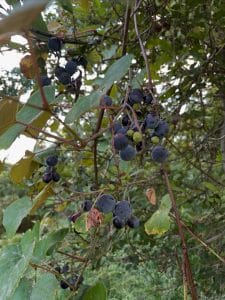
4 Responses
I have read that the hip seeds have fine hairs that can cause intestinal irritation. Have you had to deal with this at all? Will mashing and putting them in tea take care of this issue?
There are fine hairs, you can strain them out with a cloth if you make tea. if you happen to eat a few its not a big deal. I’ve eaten plenty of rose hips and eaten the hairs by accident.
Can’t wait to learn more
Animals eat the rose hips for food then , carry the seeds around to a new place. The purpose of the fine irritating hairs is to cause animals like deer or rabbits to “release ” the seeds in a new location with plenty of ready to use fertilizer .